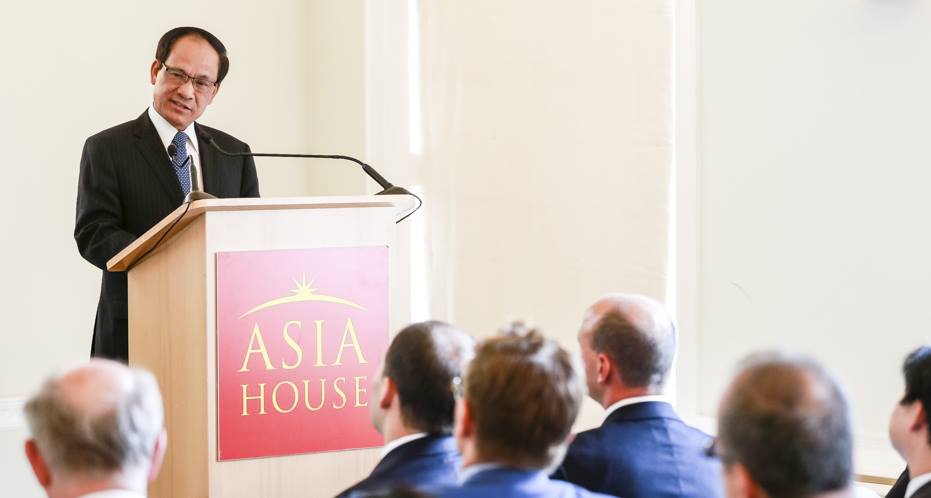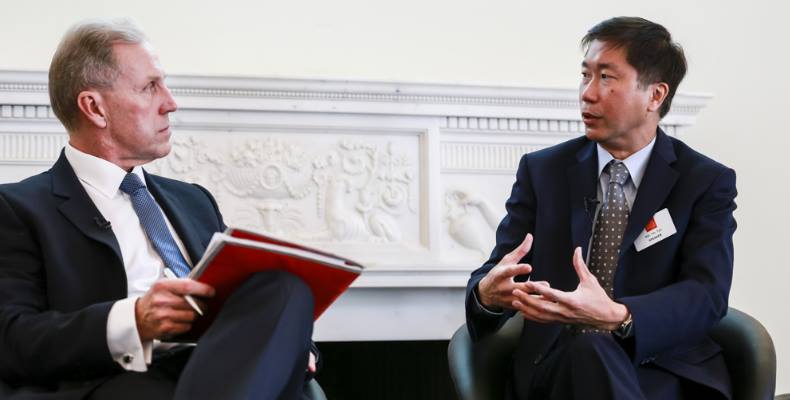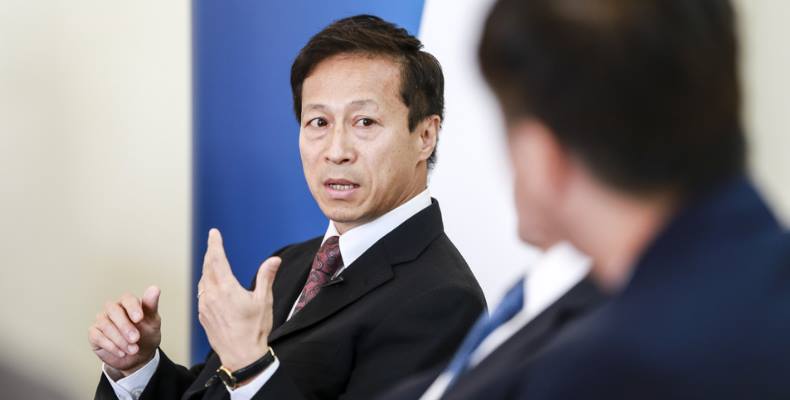Driving commercial and political engagement between Asia, the Middle East and Europe
Driving commercial and political engagement between Asia, the Middle East and Europe
Driving commercial and political engagement between Asia, the Middle East and Europe

The diversity of ASEAN is one of its strong points and makes the region more rather than less attractive to multinationals, claims the ASEAN Secretary-General.
HE Le Luong Minh was the keynote speaker at a conference ‘ASEAN Strategy – Seizing the New Regional Opportunity,’ held at Asia House, in partnership with KPMG. He said that whilst ASEAN’s diversity created challenges as the region undertook further integration, “contrary to the concern of some, a key factor behind ASEAN’s rise has been its diversity.”
“Member States are at vastly different levels of economic and infrastructure developments with diverse market sophistication,” he explained. “Regulatory transparency and consistency of financial services differ across region.”
But he said those different levels of economic development meant the region boasted all stages of the value chain.
“Differences in levels of income and income disparities mean different cost structures in the region,” he said. “There are frontier markets that remain largely untouched by foreign investors. There are member economies which are wooing investments in the high-value chain industries and in between there are Member States that possess either vast natural resources or an enormous commodities base. This allows for better value chain propositions such as locating manufacturing operations in those ASEAN countries with more accessible labour, whilst locating service industries in the more advanced ASEAN Member States,” he explained.
He admitted much more needed to be done to make integration happen. “There is a need for Member States to enforce strict rule-of-law and bring their national regulations in line with each other. Without these businesses cannot trade effectively throughout ASEAN. Banks must also ensure that they are governed to the highest standards,” he said.
But Mr Minh said the realisation of the ASEAN Economic Community (AEC) at the end of 2015 would alleviate these concerns. He said Member States were actively working to launch the AEC which meant transforming ASEAN into a region with a free flow of goods, services, investment, capital and labour.
“ASEAN is the only organisation in the world to have concluded free trade agreements (FTAs) with all the major and middle economies in the Asia Pacific. Through these FTAs, ASEAN is well positioned at the centre of regional and global supply chains,” he pointed out.
ASEAN is presently negotiating a Regional Comprehensive Economic Partnership (RCEP), a mega FTA, between the 10 Member States of ASEAN and the six nations that it has existing FTAs with (Australia, China, India, Japan, South Korea and New Zealand.) All of this makes ASEAN more attractive to investors, as they will push up trade and investment in the region since not only can regional businesses look to trade with counterparts from across the region, but they can also capitalise on trade flows that carry goods to big markets in the region, like China, India and the rest of the world.
Once concluded, the envisaged RCEP will account for about 30 per cent of global GDP. “It is expected to transform East Asia into an integrated market of 3.3 billion people – half the world’s population – providing tangible benefits to businesses through improvements in market access, trade facilitation, regulatory reform and a more liberal rule-of-origin,” Mr Minh said.
A decade ago the majority of Western companies that came to Asia identified only China as the preferred option when setting up manufacturing facilities, he said. They were encouraged by China’s competitive wages, developing infrastructure and the vast opportunities presented by its domestic market. “This has begun to change as ASEAN becomes more accessible and increasingly cost-competitive,” he explained.
Last year FDI inflow to ASEAN was at an all-time high reaching US$136 billion, representing 15.7 per cent year on year growth.
ASEAN is now the third largest economy in Asia and the seventh largest economy globally. It has been the second fastest growing Asian economy over the past decade with a combined GDP of US$2.8 trillion in 2014 and a combined population of 625 million, almost twice the size of the USA and half of China’s. ASEAN’s purchasing power is expected to double within 15 years with an expanding middle class. “The ASEAN region is also a critical commodity producer meeting the ever-growing demand of raw materials around the world,” Mr Minh said.
He also pointed out that the GDP growth rate of the region in recent years had remained stable at about five per cent, despite the impact of the global and Eurozone crises. ASEAN is projected to be the fourth largest economy in the world by 2050 and it is expected to have 163 million middle class households with strong consumption power by 2030.
Mr Minh said that ASEAN economic integration had been a “game changer” for the Southeast Asian region.
“While the region is diverse and varied, the growing middle classes in ASEAN share similar demands and consumption patterns. This should allow companies to build broader regional platforms and take advantage of economies of scale. Also, the elimination of internal tariffs and further reduction in non-trade barriers will allow multinationals (MNCs) to plan for an eventual single market,” he said.
Mr Minh said the AEC would help ASEAN economies fully open their markets to regional neighbours, reduce cross country disparities and narrow the development gaps. “It will be a stepping stone for poorer countries to move up the value chain and maximise their growth potential,” he said.
Speaking in an interview on the sidelines of the conference Mr Minh said there were a number of opportunities for MNCs in ASEAN. “There is huge potential for investment in ASEAN’s demand for physical infrastructure such as roads, rail and ports, estimated at US$ 100 billion per annum.
“Rising middle-class consumerism will also mean demand for housing, shopping malls and leisure outlets. Demand for consumer goods, clothing and apparel, prepared foodstuffs, transportation equipment and consumer electronics are expected to rise exponentially,” he added.
He said the travel industry in ASEAN would continue to see strong rates of growth and so ancillary and associated industries like hotels and airlines would also see strong expansion.
“Financial, investment and medical services will also grow in tandem with a more wealthy society. E-commerce will also be important,” he added.
“The challenges will be the same for business everywhere, which are to know your markets and be sensitive to consumer demands. To mitigate risks companies should also be knowledgeable about local conditions and work with local partners. Ideally MNCs should be in ASEAN for the long haul and have their brands made better-known and trusted,” Mr Minh said.
“I urge the global business community to re-orient their strategies from focusing on localised markets to a regional approach to encompass all ASEAN Member States. With lower tariffs, better mobility of good and greater synchronisation of policies, I am sure that ASEAN will appeal to those MNCs which are interested in building a regional platform in Southeast Asia.”
However, one dilemma global corporates face, as the region gets more integrated, is whether to have a regional or country strategy.
Representatives from multinationals who were panellists at the conference, said that despite further integration they did not feel they needed a “regional strategy” and still advised a country approach. They all agreed Singapore was the best place to be headquartered because of its connectivity, legal system and financial infrastructure.
Min Yih Tan, General Manager for Global Retail & Commercial Strategy at Shell, said: “Do we need a regional strategy? Not really. Even in the EU we don’t have an EU strategy.”
But he said the key to success in ASEAN was to “empower the frontline and move more decision-making to the country.”
There were some concerns expressed at the conference about the political stability in the region owing to tensions in the South China Sea.
However Tan said despite tensions in the South China Sea, there were “still opportunities in ASEAN.”

Min Yih Tan, General Manager for Global Retail & Commercial Strategy at Shell discusses the keys to success in ASEAN. Copyright Miles Willis Photography
This view was backed by Klaus Landhaeusser, Regional Head for External Affairs and Government Relations at Robert Bosch South East Asia, who said: “The region has tremendous growth potential and having had businesses there for a long time, we have overcome lots of crises and natural disasters. You have to shift decision-making to local markets. We have learnt that the same things do not work in all the ASEAN countries as they are very diverse. We have different ways of doing business in different countries and different business models,” he said.
He said another key to success in ASEAN was hiring local people, even if found outside their native countries, as they know how to handle local issues that may arise. He said setting up regional training centres and training local staff was a good option too. “We look at each country in ASEAN – we don’t think of it as one region because of misalignment of standards and other factors,” he added.
Paul Nichols, Seconded Partner at KPMG Singapore, said: “The businesses that are most successful now and will be most successful are the ones that can harness and develop local talent.”
He said the AEC would encourage harmonisation but it would not “be to the same extent we are used to with the EU.”
“There will still be a number of discrepancies between countries and a lot of regulation will remain quite complex,” he added.
The pending AEC means that companies will be able to transport goods across borders without having to change trucks.
Jonathan Asherson, Regional Director of ASEAN and Pacific at Rolls-Royce, said that combined with improving levels of education, infrastructure and healthcare, the growing middle-classes and the low cost business model, were all making the region “much more interesting” to Rolls Royce.
Rolls Royce also has different strategies in each ASEAN Member State.
“Eighty-five per cent of what we do in ASEAN is in four countries. In 10 to 20 years’ time that will change. One of the advantages of ASEAN is that they are all at different stages so you can plan for the long term,” he said.
However he said the Trans-Pacific Partnership (TPP) might mean “FTAs in some areas might become less productive. The voice of business in ASEAN could be stronger,” he added.
Noriyuki Sato, Executive Vice President & Executive Coordinator, Mitsui & Co. Europe, said: “As ASEAN becomes a more integrated market of more than 600 million people and it enhances its relationship with other nations via the RCEP and the TPP, this could push up trade and investment in the region even faster so we are very enthusiastic about long term growth in the region.”
But he also agreed that “political stability was the cornerstone of growth in the region”.

Noriyuki Sato, Executive Vice President & Executive Coordinator, Mitsui & Co. Europe discusses long term growth prospects in ASEAN. Copyright Miles Willis Photography
Sean Severn, Head of Markets at KPMG in Thailand, Myanmar & Laos, said: “There is a huge opportunity for businesses that operate in ASEAN to operate across jurisdictions. Large steps need to be taken to get right out to the capillaries of these countries and tap the potential of the rural classes.”
Indeed the region is lagging behind on infrastructure.
Asia needs US$8 trillion of infrastructure investment between now and 2020, according to the Asian Development Bank (ADB). Several of the panellists spoke about infrastructure challenges in ASEAN, especially getting goods to the interiors and traffic problems from airports to city centres, and the lack of a high speed train between Singapore and Kuala Lumpur.
“We are ready to finance the infrastructure but we turn down many of the projects because there is no legal certainty,” said Vasuki Shastry, Global Head of Public Affairs at Standard Chartered Bank. He also commented that financial integration lagged behind in the region which meant that “financial services were ripe for disruption.”
naomi.canton@asiahouse.co.uk
